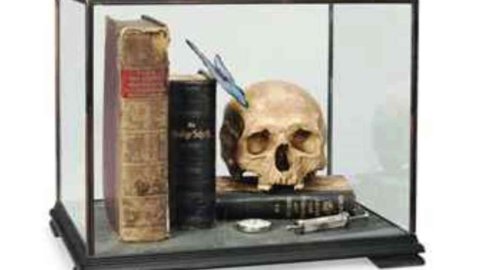Out of the Ordinary is the name of the sale offered by Christie's South Kensington, which for the works presented can be defined as very curious and full of emotions to be discovered.
Exactly 109 completely out of the ordinary lots, a miscellany of objects, fossils and minerals, sculptures, statues, posters, books, manuscripts, photographs, drawings, multiples and memorabilia.
Top lots:
THE SKULL OF A TRICERATOPS – HELL CREEK FORMATION, MONTANA, a Triceratops prorsus skull sold for USD 302,445
With its three-horned head, the triceratops is one of the more famous dinosaur species. They lived at the end of the Cretaceous before the fatal asteroid-triggered mass extinction that caused the Chicxulub crater over 65 million years ago. This herbivorous species, about 30 feet long, weighing 12 tons, roamed an area that is now east of the Rocky Mountains of North America, which then had a mild climate. They coexisted with Tyrannoraurs rex, and were preyed upon by them until they were extinct. The horns on their skulls were probably used as a defense against this formidable enemy, although a recent theory indicates that the collar may have been highly colored and for ornamental purposes, or that it served to regulate temperature. The earliest specimens found were a pair of horns which were mistaken for a Pliocene bison in 1887. Later realizing the mistake he two species, horridus and prorsus, described by Othniel Charles Marsh in 1889-1890. While the first mounted skeleton was reconstructed by the Smithsonian in 1905 and has remained on display ever since. For over a century, the Triceratops remains one of the most easily recognizable iconic species of dinosaur.
Second top lot:
ARCHITETTURA', A WOOD AND METAL TRUMEAU WITH LITHOGRAPHIC AND TRANSFER PRINTED DECORATION, DESIGNED BY PIERO FORNASETTI (1913-1988) & GIO PONTI (1891-1979), designed in 1951.
A beautiful cabinet-furniture born from the collaboration of Giò Ponti and Piero Fornasetti, estimated at 61-90 thousand USD and sold for $143,325.
Third Top Lot:
ELEPHANT BIRD EGG – MADAGASCAR, PRE-17TH CENTURY
An egg of the Elephant Bird, a flying beast also known as a Roc (or Ruhk) in the Tales of Sinbad and the tales of Marco Polo's travels. The bird about 10 or 11 meters tall and probably capable of devouring an elephant, surely was the largest bird that ever lived. It has been estimated to weigh up to 1100 pounds (the largest ostriches could grow up to 8 feet tall and weigh 300 pounds). Such bird specimens are thought to have become extinct between the 14th and 17th centuries. Estimate 46-75 thousand USD, sold for $105,885.
Fourth top lot:
THE 'WAXFLATTER' ORNITHOPTER BY ELSTREE FILM STUDIOS AND BIANCHI FILM AVIATION SERVICES FOR THE STEVEN SPIELBERG FILM PRODUCTION 'THE YOUNG SHERLOCK HOLMES', 1985
What will it be? An ornithopter. This unique and impressive artifact was built in the mid-1980s for the production of Steven Spielberg's film 'The Pyramid of Fear' which was released in 1985. The ornithopter sequence shows inventor Rupert T. Waxflatter (Nigel Archive) who developed the model and when the design is finally perfected, the Pyramid (Nicholas Rowe) flies to the rescue of Elizabeth Hardy (Sophie Ward) to escape from the clutches of Professor Rathe (Anthony Higgins). Estimate $76-120k, auctioned at $87,165.
They follow:
MAYA – HIROSHI FUROYOSHI (JAPANESE, B.1959) auctioned for USD 81,549
A PAIR OF MARK BRAZIER-JONES – sold for $68,250
A LARGE DOUBLE-CURVED WOOOLLY MAMMOTH TUSK – sold for $44,600





